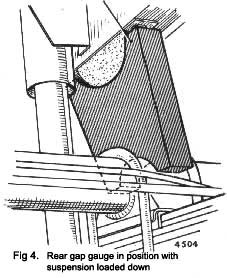4. The front wheels must be checked for “run-out”, see under “Checking Wheel and Tyre Run-Out — Wheels and Tyres, Section L”. Depending on the type of checking gauge in use, the points of maximum “run-out” are positioned so they are clear of the contact points of the checking gauge.
5. The front and rear suspension must be loaded down on to four gap gauges by placing weights on the front of the car. The approximate weight required is 300 lb. (136 kg.) evenly distributed on a platform attached to the front of the vehicle. The platform comprises a stout piece of wood supported by two suitably cranked steel bars 7/8in. (22 mm.) square located in the front jacking sockets.
At the front, steel gap gauges are used between the lower wishbone links and the underside of the cross-member. At the rear, hardwood gap gauges are
|
placed between the top of the axle casing and the chassis frame; the hardwood gauges are shaped to clear the bump rubbers and to fit on the axle casing. Normally the rear end of the car has to be lifted by hand to enable the rear gap gauges to be positioned and subsequently gripped in position by the lowering of the car. When it is found that the gap gauges are a loose fit, a small weight can be placed on the rear of the car to bring it down onto the gap gauges.
6. Keep the front wheels in the straight ahead position and gently roll the car forward until the front wheels are on the turntable gauges and the rear wheels on the wooden ramps, the latter will keep the car in a level plane. Stop the car without the application of the brakes so the free condition of the turntable gauges is not disturbed.
Lock all four wheels by blocking the brake foot pedal in the down position.
|
 **
**

